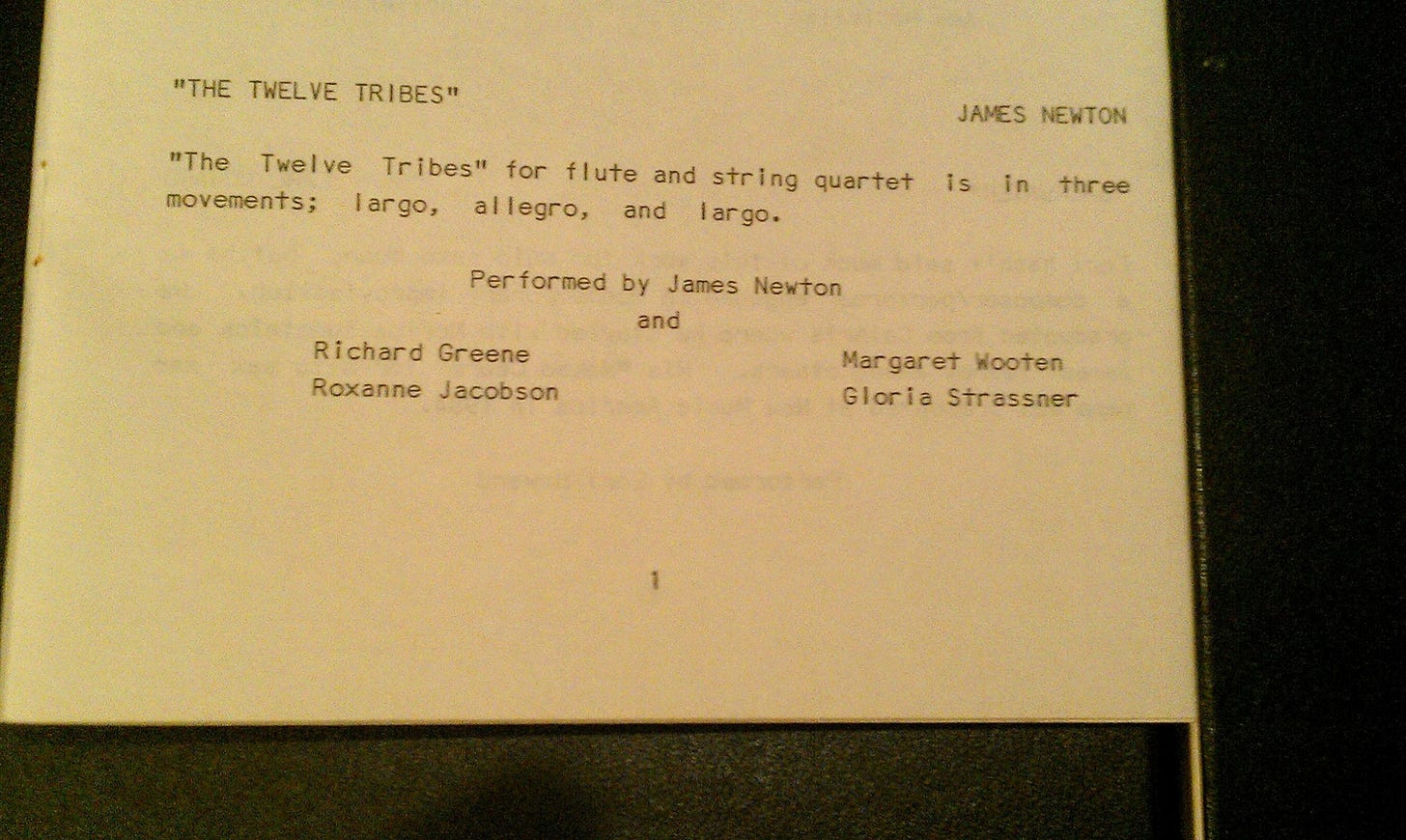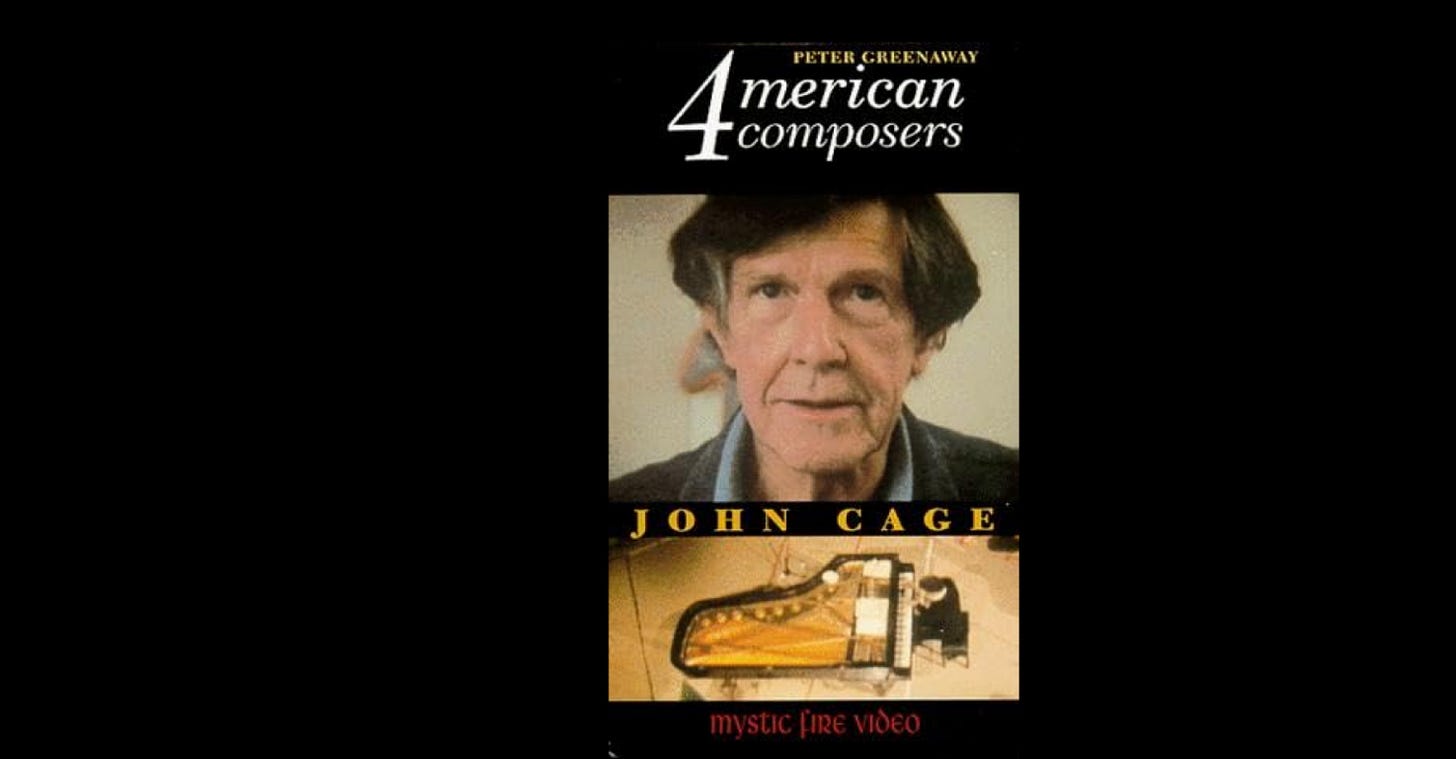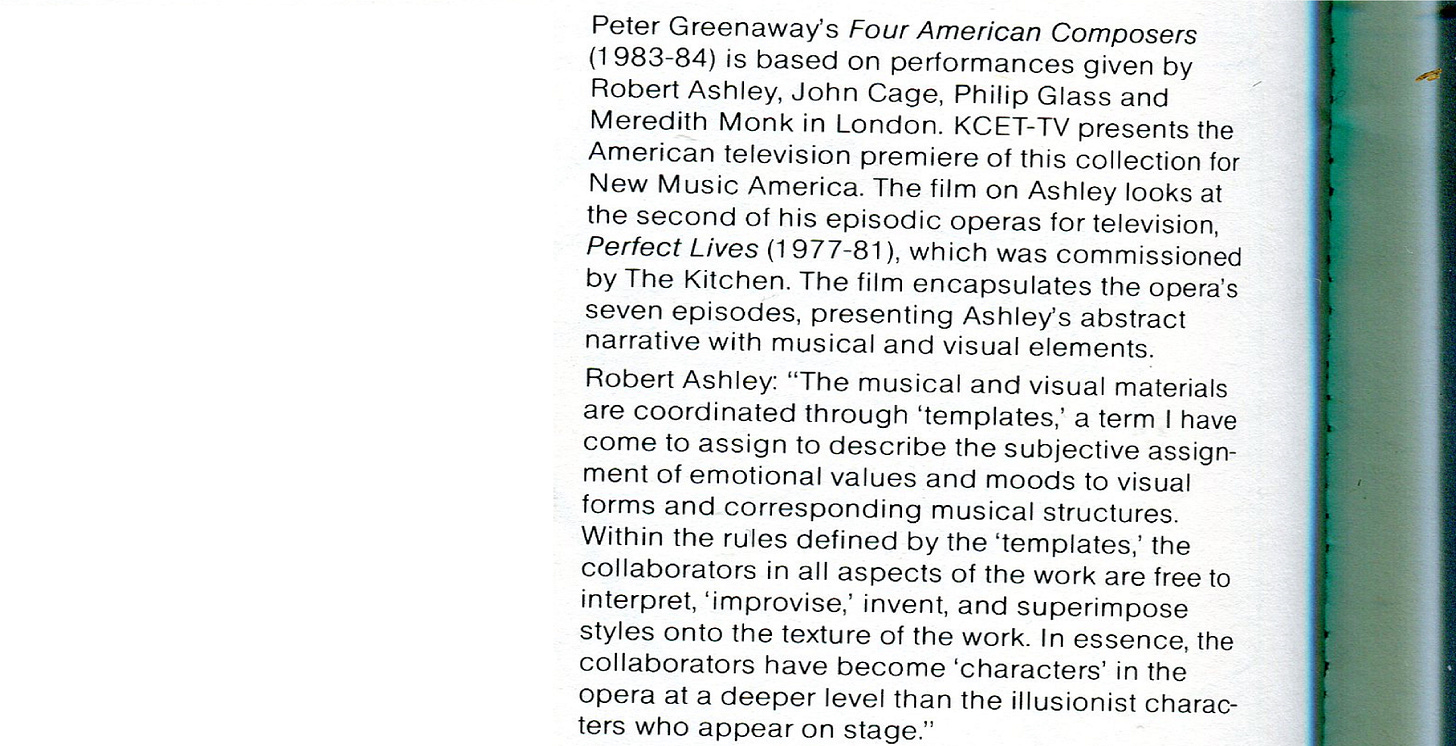november 2, 1985 new music america los angeles day 3
R-Unit ● Kronos Q. ● Harold Budd ● Residents ● Aki Takahashi ● Morton Feldman ● Stephen Scott ● Lois V Vierk ● James Newton ● John Schneider ● Paul Demarinis ● Earl Howard ● John Cage ● Robert Ashley
November 2, 1985
Repercussion Unit and Kronos Quartet "A Young Person's Guide to New Music - I"
Launching of VideoLACE series
Harold Budd "Blue Room With Flowers and Gong"
Residents Visual art from "The Mole Show"
Various artists "Before There Was MTV" VideoLACE highlights
Kronos Quartet with Aki Takahashi Morton Feldman: "Music for Piano and String Quartet" (world premiere)
Stephen Scott Ensemble: Chris Baker, Dee Baker, John Cook, Susan Lance, Amy McClellan, Eve Pollak, Lezlie Roach, Elizabeth Stanton, Karl Walter "Minerva's Web"
James Newton with Richard Greene, Margaret Wooten, Roxanne Jacobson and Gloria Strassner "The Twelve Tribes"
John Schneider (accompanying Dave Seidel x 4 on tape) Lois V Vierk: "Go Guitars"
Paul Demarinis "Beneath the Numbered Sky", "Novena"
Earl Howard "Backwater"
Peter Greenaway "Four American Composers: John Cage"
Peter Greenaway Four American Composers: Robert Ashley
=============================
Repercussion Unit and Kronos Quartet "A Young Person's Guide to New Music - I"
♪
Launching of VideoLACE series
♪
Harold Budd Blue Room With Flowers and Gong
Residents - visual art from The Mole Show
Like a number of Californian composers of his generation he has an interest in the more meditative forms of music, in the idea of a controlled musical environment, and in a sense of non-doctrinaire spirituality. Some works from the 1960’s are concerned with the idea of installation, in the visual art sense. Magnus Colorado (1969), for several gongs, asks for a “very soft coloured light” to flood the performance area. Lirio (1971) has the simple notation “under a blue light, roll very lightly on a large gong for a long duration”. Intermission Piece (1968) is a verbal score that sets up conditions for an ambient performance in any intermission (concert, play etc.) in a way not unrelated to Satie’s earliest essays in his musique d’ammeublement (1920). Even Madrigals of the Rose Angel (1972), a later work for female choir, has the note that it should be performed “with dark lighting, maybe blue, preferably from above. It would be nice if the chorus were topless”. To my knowledge this piece still awaits an authentic performance. As late as 1985 he included a piece in the New Music America Festival , Blue Room with Flowers and Gong which continued this concern for a total experience of both music and space. He has often spoken of the impact of the paintings of Mark Rothko on him, and there is a clear connection between these works and minimal or colour-field painters from the 1950’s onwards.
- From Gavin Bryars’ website, “Writings: Harold Budd”
*
What do you have lined up when you return to the States? Will there be another solo album?
Yes. It'll be a solo work on EG. Half of it is already done, and the other half I have to do this summer. I have a lot of work to do on it because I haven't got the foggiest idea what I'm going to do.
The first side is a full twenty-minute piece. It was done in LA, using the Fairlight and Synclavier, and a general array of Oberheim keyboards including the Matrix 12. I use the Matrix in a very unsophisticated fashion, which is to say that although it's multitrack, everything is a live performance. I'm not even using the Synclavier to make the notes proper: it's me, what you hear is the way I'm hitting it.
The piece's working title is Gypsy Violin, because that's the name of one of the factory presets I used on the Synclavier. It's a gypsy violin sound and it's excellent.
I originally did the piece for an art gallery installation in Los Angeles last November. It was called Blue Room With Flowers And Gong - which describes exactly what it is. It's an environment through which you walk, or just take a quick look and walk away and think 'this guy's crazy'. It was originally the length of one side of a C60 cassette, but that version went on a bit - the sustained notes and so on...
- 1986 Harold Budd interview with Dan Goldstein found at https://www.moredarkthanshark.org/eno_int_eamm-jul86.html
*
The Los Angeles Institute of Contemporary Art presents an exhibition of two music installations by The Residents and Harold Budd, in conjunction with the 1985 New Music America Festival. Opening Tuesday, the presentation offers visual and aural access to these composers’ works.
The Residents, a group of San Francisco area composers, will exhibit sets from their Mole Show tour which sought to activate interest in a variety of creative fields: music, theater, literature, painting/sculpture, dance, film/video and computer programming.
The Residents who were invited to open the New Music Festival in Washington in 1983, are publishing their 16th recorded album. The audio part of the installation will feature recorded works never before heard in this country. Harold Budd’s Blue Room with Flowers and Gong is an installation with taped music. Budd, a Los Angeles based composer whose work is often defined as “minimal,” performs it using the piano and electronically altered versions of keyboard sounds. He has held solo concerts in New York, Rome, Paris, Los Angeles, San Francisco and Tokyo. The composer/performer has recently been producing his own recordings on the Cantil/Jem label and has collaborated with Brian Eno on two recordings released by EG. Harold Budd will be at LAICA on Saturday at 2 p.m.
- Josine Ianco-Starrels, Los Angeles Times (Entertainment and Arts section) October 27, 1985
♪
Kronos Quartet with Aki Takahashi Morton Feldman: "Music for Piano and String Quartet" (world premiere)
One of the rare works that gets its own Wikipedia page:
https://en.wikipedia.org/wiki/Piano_and_String_Quartet_(Feldman)
*
Morton Feldman’s Quintet, which he calls Piano and String Quartet, was written expressly for the Kronos Quartet and pianist Aki Takahashi for performance at this festival. Like some other Feldman works, it seems at first overlong for its content, seems to invite clockwatching and taxes the listener’s--any listener’s--patience.
Sixty-eight and one-half minutes long, the quintet deals in quiet music. The prevailing dynamic never rises above mezzo-piano; at least it did not so rise in this world-premiere performance.
At the beginning of the work, musical activity is confined mostly to arpeggiated chords in the piano and disjunct responses from the quartet; later, the dialogue between piano and strings takes different tacks. At no point in the score does anything change strikingly; once begun, the piece offers no surprises.
Its sound profile, then, is inoffensive. The slow-changing of exotic chords at low dynamic levels does not challenge or grate upon the ear. But it does make for one long period of uneventfulness.
The Kronos Quartet--violinists David Harrington and John Sherba, violist Hank Dutt and cellist Joan Jeanrenaud--and pianist Takahashi treated the work with loving tenderness, caressing its barely changing outlines, carefully defining its short dynamic parameters. After the conclusion of the performance, the composer gratefully acknowledged the performers’ successful efforts.
Of course, by that time, a portion of the large audience gathered in Leo S. Bing Theatre at the museum had fled--quietly at first, then, later, with growing bravado.
By chance, one had the opportunity to hear the work again, three hours later, on KUSC-FM, which is broadcasting festival events. The second hearing confirmed one’s impressions: Much does happen in these 68 1/2 minutes, though slowly: A certain inevitability seems to govern the chord-changes, a formal structure emerges, and a number of leitmotifs appear and recur--they even haunt the work. One of them is a chord, spelled, from bottom to top: F; A; G; A-flat.
- Daniel Cariaga, “Feldman Quintet, Other Works Premiere at Fest”, Los Angeles Times, November 4, 1985
♪
Stephen Scott Ensemble: Chris Baker, Dee Baker, John Cook, Susan Lance, Amy McClellan, Eve Pollak, Lezlie Roach, Elizabeth Stanton, Karl Walter Minerva's Web
There are no videos for Minerva’s Web that I could find, but to see the group perform, there is one for a work named Entrada which I’ve already posted on Scott’s birthday; on the other hand, I found this today which is cool as well:
Oh, after the initial posting, I was able to locate this interview that Stephen Scott had with Charles Amirkhanian at the time (broadcast on the Canadian mothercorp) and followed by D. Grimes and L. Majors introducing the actual performance of Minerva’s Web.
♪
James Newton with Richard Greene, Margaret Wooten, Roxanne Jacobson and Gloria Strassner "The Twelve Tribes"
He would perform this as well during the closing CalArts weekend which is from where this notice comes. Unfortunately, since it’s a biblical reference, it’s kind of hopeless trying to use google to find out more about this work in particular… research always ongoing, though!
♪
John Schneider (accompanying Dave Seidel x 4 on tape) - Lois V Vierk: Go Guitars for 5 electric guitars
Lois V Vierk’s CD Simoom which contains Go Guitars for 5 electric guitars, Cirrus for 6 trumpets and Simoom for 8 cellos
https://xirecords.org/102.shtml
♪
Paul Demarinis: Beneath the Numbered Sky, Novena
♪
Earl Howard "Backwater"
*
unsigned review from the Los Angeles Times
♪
Peter Greenaway, director
Four American Composers: John Cage
y2b version of the film (complete it seems):
Ubufilm stream version of the same film: https://www.ubu.com/film/greenaway_cage.html
♪
Peter Greenaway, director
Four American Composers: Robert Ashley
excerpt on y2b:
Ubufilm stream of the complete film, including film review by Brian Robison of Cornell University
https://www.ubu.com/film/greenaway_ashley.html
program description


















